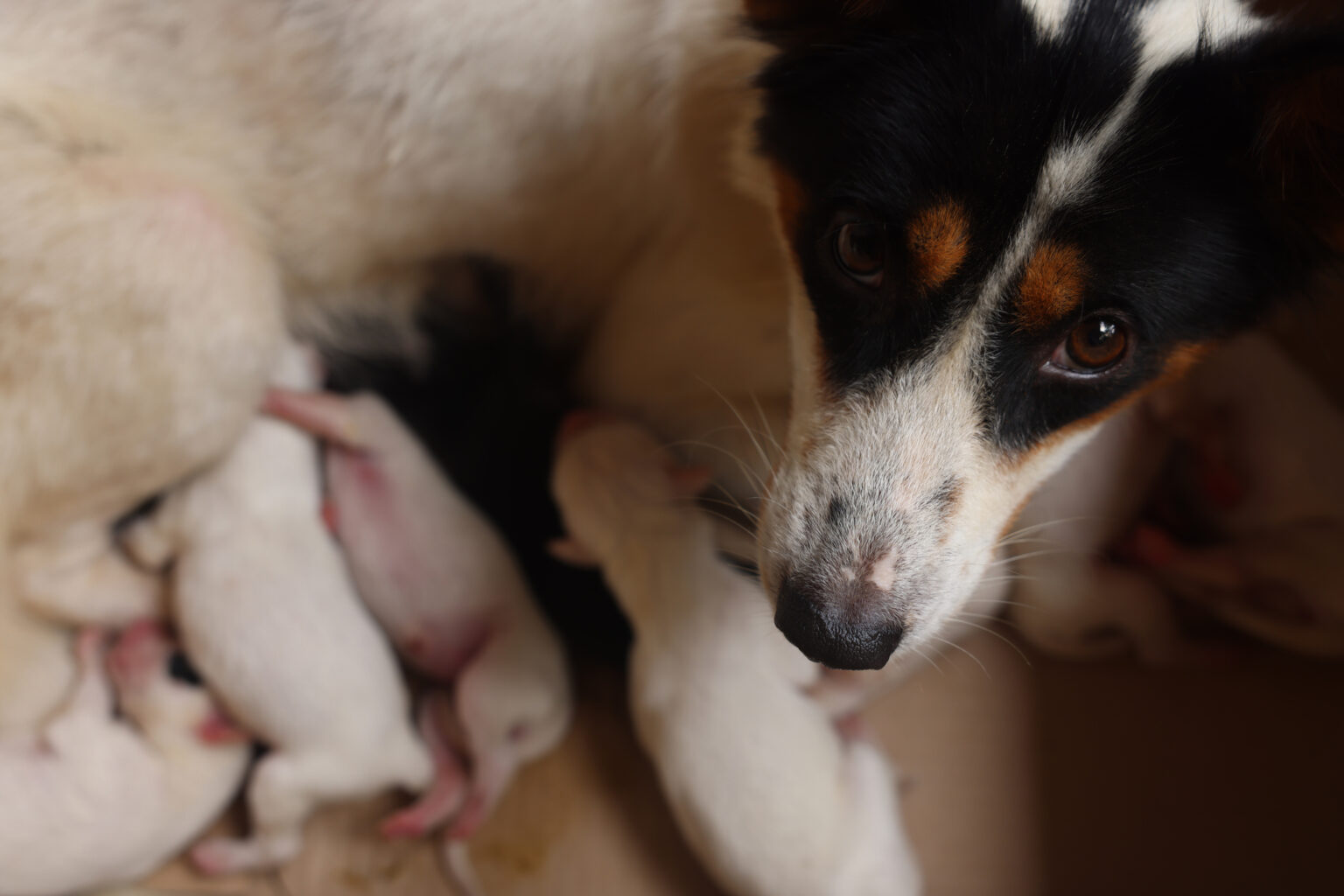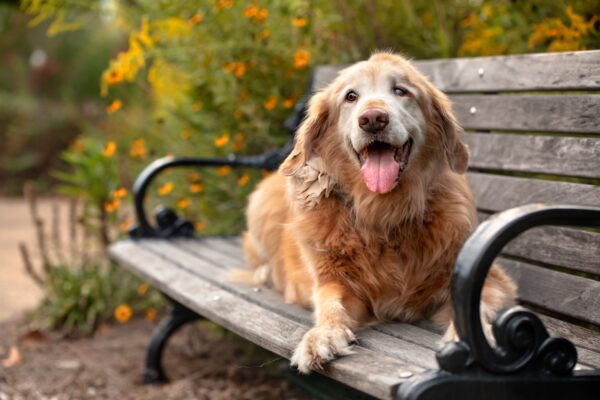Breeding from your female dog is not a decision that should be taken lightly. It is a time-consuming, messy, expensive, and sometimes heart-breaking enterprise. However, if you have done your research and are happy to proceed, this guide will help you to recognise some of the problems that can occur during and after whelping.
If your dog is pregnant, it is important to know when the puppies are due, and if possible, how many you are expecting. An x-ray a week before the puppies are due can give a good approximation of how many are expected, so you are more likely to know if a problem arises before all of the puppies are born. Talk to your vet for more details on veterinary care during pregnancy.
Main complication during dog labour
Dystocia is the term used when the mother-to-be is not progressing through labour as expected due to a problem.
Causes of dystocia:
- The shape and size of the pelvic canal. If the pelvis is narrow, either due to breed conformation or because of a previous fractured pelvis, delivering puppies may be difficult. This is especially true if the dog has a large head relative to the size of the pelvis.
- The breed. Breeds predisposed to dystocia include British Bulldogs, French bulldogs and boxers.
- Uterine inertia can also cause dystocia. Uterine inertia occurs when the uterus is no longer able to contract and push the puppies through the vaginal canal. It can occur at any stage of labour and may be associated with uterine exhaustion.
- The size of the pups can cause dystocia. If the puppy is too large, it will not fit in the birth canal. This can be common when there is only a single puppy in the litter.
- Puppies’ position are normally born either head first or rear legs first. If the puppy is sideways or bottom first, they become stuck.
- Developmental defects that result in enlargement of certain body parts can make birth difficult.
- Death of the puppy in utero can result in abnormal positioning and can affect uterine contractions.
Time to call the vet:
- Your dog has been pregnant for over 63 days.
- Stage I labour has gone on for 24 hours without producing a pup
- Stage I normally lasts 6 to 12 hours – the dog will exhibit nesting behaviour and her temperature will drop.
- Steady strong contractions have continued for over half an hour without producing a pup.
- Prolonged resting phase continues over 4 hours when there are more pups to be delivered.
- There is a foul-smelling or bloody vaginal discharge.
- The mother-to-be has excessive vomiting or is extremely lethargic.
Treatment:
First, your veterinary surgeon will do a physical examination, including a vaginal exam, to determine whether the pups can move through the birth canal. An x-ray to determine the size, shape and number of pups may also be necessary. If your vet feels the pups can move through the birth canal, there are a variety of medications available to assist labour.
- If uterine inertia is suspected, medication can be administered to stimulate contractions of the uterus.
- After prolonged labour, the mother may have low blood sugar or low blood calcium. In this case, your veterinarian will give calcium and dextrose injections which can help strengthen uterine contractions
- If easy passage is not possible, or if medical treatment is not effective, your veterinary surgeon will deliver the pups by Caesarean section.
Prevention:
There is little that can be done to prevent dystocia, but having good knowledge of what to expect from the birthing process and detecting problems early – resulting in prompt veterinary assistance – will give the mother the best chance of delivering live, healthy puppies.
Most common problems post whelping
Most post-whelping problems are seen within the first few hours after whelping. Sometimes conditions occur that mean the bitch is unable to feed her pups, and they will have to be hand-reared and fed milk replacer. It is important that if this is the case that the puppies receive colostrum to ensure they have a good immune system.
Eclampsia is caused by low blood calcium levels (hypocalcaemia) in dogs. The lactating (milk-producing) mother is especially susceptible to blood calcium depletion because the body cannot keep up with the increased demand for calcium. This is because dogs lack the ability to quickly move calcium into their milk without depleting their own blood levels of this mineral.
Litters do not need to be large to cause eclampsia. Small breed dogs are at higher risk than larger breed dogs. The puppies themselves are not affected as the mother’s milk appears to be normal during this period.
Signs:
Eclampsia is a very serious disorder but fortunately, the signs are fairly easy to recognise. Affected dogs may:
- Appear restless and nervous
- Walk with a stiff gait and may even wobble or appear disoriented
- Become unable to walk and her legs may become stiff or rigid
- Fever, with body temperature even over 40º C.
- Affected bitches often develop muscle tremors
- The respiration rate (number of breaths per minute) will increase
- Seizures may also occur, at this point; death can occur if no treatment is given
Treatment:
Seek veterinary attention at once and prevent the puppies from nursing for at least 24 hours. Feed them with a commercial milk replacer. A veterinary surgeon can confirm eclampsia with a blood test to determine blood calcium levels. Eclampsia can be rapidly corrected by your vet through the use of intravenous calcium supplementation.
Prevention:
Adequate amounts of calcium need to be consumed by the pregnant bitch, but not so much that the production of parathyroid hormone is reduced. Parathyroid hormone is essential for maintaining adequate blood calcium levels. This means calcium supplements are generally not recommended. Also, it is important for the calcium and phosphorus in the diet to be at the correct ratio of 1 part calcium to 1 part phosphorus and vitamin D must also be present. Puppy foods are formulated with the correct ratios of calcium and phosphorus, so these are the best option to feed your bitch.
Haemorrhage is when your dog experiences a heavy significant flow of blood any time after whelping. This is a very serious emergency, so you will need to call your vet immediately.
Signs of retained placentas or puppies may follow whelping immediately, or several days later. Symptoms include:
- Persistent vomiting
- Dehydration
- Lack of appetite
- Depression
- Weakness
- Green vaginal discharge
These are all signs of a retained placenta, or even a retained puppy. Seek veterinary advice immediately.
Metritis means inflammation of the uterus (womb), and is usually associated with infection. Uterine infections are emergencies that can be fatal if not treated quickly. Metritis sometimes follows after long or difficult labor.
Symptoms include:
- Fever
- Weakness
- Depression
- Dehydration
- Dull eyes
- Reduced milk production
- Foul smelling discharge from the vagina.
This condition is very serious and requires immediate veterinary attention.
Mastitis refers to swelling, inflammation, and infection of the mammary gland and is typically caused by three kinds of bacteria: E. coli, Staphylococcus, or Streptococcus. Mastitis is most often seen in dogs during the first two weeks after delivery.
Symptoms include:
- Affected mammary glands are typically hot, swollen, firm to hard and may be painful to the touch
- Severely infected glands may be black in colour or even rupture, leaking a foul-smelling pus discharge
Mastitis is fairly easy to treat but can be deadly if left untreated. Seek veterinary advice immediately.
Maternal damage to puppies
In rare cases, the mother can cause damage to her own puppies. In some cases, this is accidental – the mother tends to eat the placenta and sometimes goes a bit too far and can cause damage to the puppy’s umbilical area. In other cases, the mother can bite or eat her puppies. Therefore, it is wise to observe the mother carefully for the first few days after birth. If she does this, it is not a good idea to breed from her again, and she should be spayed as soon as the vet deems it possible.



